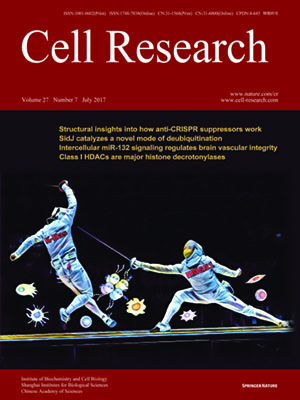
Volume 27, No 7, Jul 2017
ISSN: 1001-0602
EISSN: 1748-7838 2018
impact factor 17.848*
(Clarivate Analytics, 2019)
Volume 27 Issue 7, July 2017: 865-881 | Open Access
ORIGINAL ARTICLES
A unique deubiquitinase that deconjugates phosphoribosyl-linked protein ubiquitination
Jiazhang Qiu1,2, Kaiwen Yu3, Xiaowen Fei2,4, Yao Liu2, Ernesto S Nakayasu5, Paul D Piehowski5, Jared B Shaw6, Kedar Puvar7, Chittaranjan Das7, Xiaoyun Liu3 and Zhao-Qing Luo1,2
1Center of Infection and Immunity, The First Hospital, Jilin University, Changchun 130001, China
2Purdue Institute for Inflammation, Immunology and Infectious Disease and Department of Biological Sciences, Purdue University, West Lafayette, IN 47907, USA
3Institute of Analytical Chemistry and Synthetic and Functional Biomolecules Center, College of Chemistry and Molecular Engineering, Peking University, Beijing 100871, China
4Department of Biochemistry and Molecular Biology, Hainan Medical College, Haikou 571101, China
5Biological Sciences Division, Pacific Northwest National Laboratory, Richland, WA 99352, USA
6Environmental Molecular Sciences Laboratory, Pacific Northwest National Laboratory, Richland, WA 99352, USA
7Department of Chemistry, Purdue University, 560 Oval Drive, West Lafayette, IN 47907, USA
Correspondence: Zhao-Qing Luo,(luoz@purdue.edu)
Ubiquitination regulates many aspects of host immunity and thus is a common target for infectious agents. Recent studies have revealed that members of the SidE effector family of the bacterial pathogen Legionella pneumophila attack several small GTPases associated with the endoplasmic reticulum by a novel ubiquitination mechanism that does not require the E1 and E2 enzymes of the host ubiquitination machinery. In this case, ubiquitin is first activated by ADP-ribosylation at Arg42 by a mono-ADP-ribosyltransferase activity; the intermediate is then cleaved by a phosphodiesterase activity also residing within SdeA, concomitant with the attachment of ubiquitin to serine residues of substrate proteins via a phosphoribosyl linker. Here we demonstrate that the effect of SidEs is antagonized by SidJ, an effector encoded by a gene situated in the locus coding for three members of the SidE family (SdeC, SdeB and SdeA). SidJ reverses ubiquitination of SidEs-modified substrates by cleaving the phosphodiester bond that links phosphoribosylated ubiquitin to protein substrates. SidJ also displays classical deubiquitinase activity but does not require catalytic cysteine residues. Further, these deubiquitinase activities of SidJ are essential for its role in L. pneumophila infection. Finally, the activity of SidJ is required for efficiently reducing the abundance of ubiquitinated Rab33b in infected cells within a few hours after bacterial uptake. Our results establish SidJ as a ubiquitin-deconjugating enzyme that functions to impose temporal regulation on the activity of SidE effectors. SidJ may be important in future studies of signaling cascades mediated by this unique ubiquitination, one that also potentially regulates cellular processes in eukaryotic cells.
10.1038/cr.2017.66
FULL TEXT | PDF
Browse 2454


